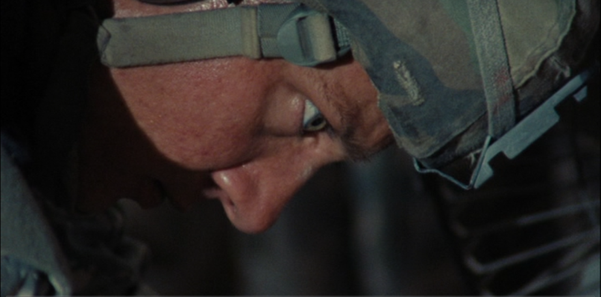"A Different Kind of War Film: The Ethos of the Individual Soldier in The Hurt Locker"
|
Mikal LambdinMikal has a BA in English with a concentration in Writing and Rhetoric from George Mason University. She most recently worked as an Undergraduate Research Assistant for Writing Across the Curriculum, where she wrote research-driven blog posts about composition from a student perspective. She enjoys pushing the envelope when writing by creating her own rhetorical frames and finding connections between dissimilar topics like children’s literature and politics. Mikal lives in Arlington, Virginia, with her doctor-to-be husband and hyperactive cat. Contents"I Don't Know": Leaving Things Out "I Don't Know": Leaving Things Out Cont. "I Wanna Die Comfortable": War is a Game "I Wanna Die Comfortable": War is a Game Cont. "With Me I Think It's One": Man Over Machine |
"With Me I Think It's One": Man Over MachineJames’s moments of vulnerability are few and fleeting, and yet they are an utterly essential part of his rhetorical make-up. Without this vulnerability, his anonymity and detachment would be overbearing and ineffective, stripping him of his ethos as an individual and turning him into another cliché of masculinity – more machine than man. His anonymity makes him believable, his addiction and resulting detachment make him unique, and his vulnerability ties everything together by making him human. Despite what the audience may hope, these moments of honesty do not transform James. He does not suddenly find himself, overcome his faults, and go on to lead a new life. And yet, these vulnerable moments sustain the thought that maybe he could, and that is their true rhetorical purpose. Ultimately, whether James changes or not, we have to believe that he can. This feeble possibility is, in itself, a powerful tool – it’s all that is needed to authenticate James’s ethos as human, with all its potential for good as well as evil. In one of the more sobering scenes in the film, James discovers a body bomb in a warehouse, claiming that the victim is a young boy he met in an Iraqi market. This is James’s first clear expression of vulnerability, as he tenderly cares for the body before detonating the warehouse. Another defining aspect of this scene is its minimal dialogue and added focus on the actions of the character. While the previous analysis in this essay has focused on dialogue primarily and actor portrayal secondarily, the analysis of this scene will emphasize actor portrayal, using a number of stills in place of a block quote:     James’s reaction to the body bomb is easily the most powerful display of emotion that he offers in the film. After telling soldiers Sanborn and Eldridge to prepare to detonate the warehouse, James is left alone with the body. He stares at it for just a moment before walking away, cursing under his breath and choking back vomit. This response, understandable from most, is unexpected coming from James: it is the first time he has ever shown clear distress. Making a focused effort to regain his composure, he abruptly arranges the C4 on the body, but his hand hovers over the last block, his eyelashes fluttering. Within moments James has removed the C4 and is frantically ordering Sanborn to “cancel the det.” His movements instantly go from being rigid and systematic to gentle, as he places a hand over the boy’s face and closes his eyes. James removes his helmet and clenches his fists against his head in a burst of raw emotion. The moment is over as quickly as it began, but this image of James, his eyes closed and tears on his face, is striking. He again regains control and proceeds to remove the bomb from inside the body, agitated but controlled all the while. The scene ends with a final, stark shot of James leaving the warehouse carrying the boy’s body, carefully wrapped in a white cloth. The silence in this scene is palpable, enhancing every action and facial expression, no matter how unassuming. This approach avoids the blunder of words, which can give way to overbearing, cliché displays of emotion; instead, actions are used to express James’s vulnerability with subtlety and honesty. This scene, which occurs just over half way through the film, is critical, allowing the audience to view James as human for the first time. The unshakable soldier is finally shaken, experiencing fear, grief, and even weakness when faced with the death of this child. Here James shows that he can, in fact, care about other people. He has the natural human impulse to create connections and foster loyalty, an impulse that is reinforced when he attempts to hunt down the boy’s killers. James may be tough, but he is not indestructible. This scene allows him to bleed just enough to confirm that he is not made of metal, without undermining his detached, war-addicted nature. |